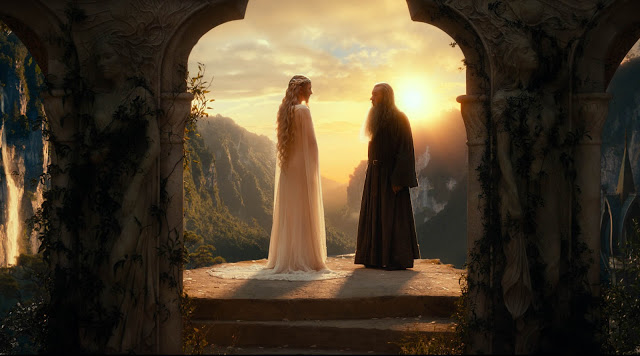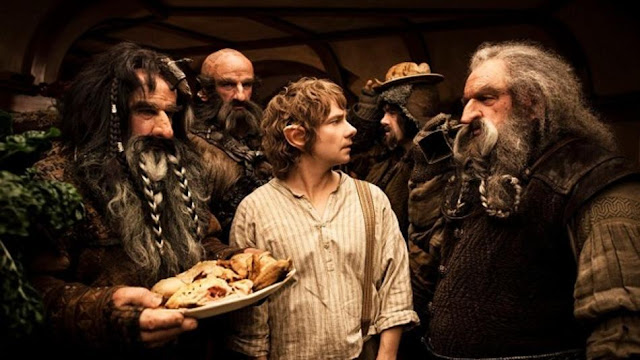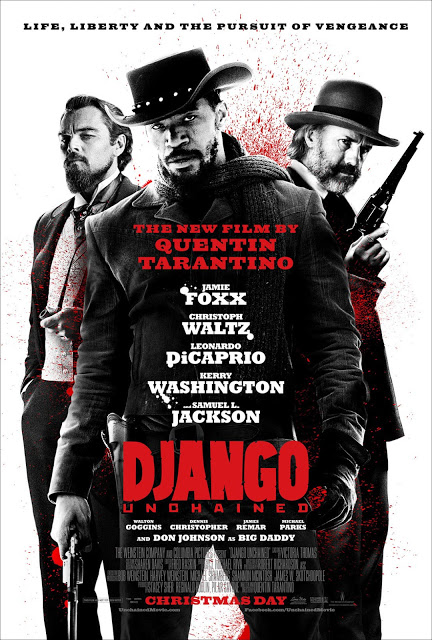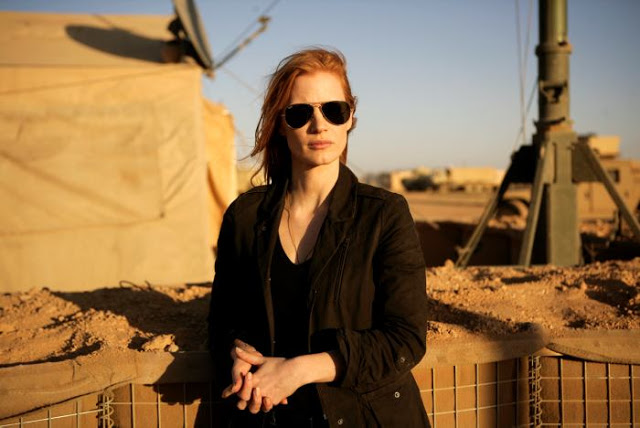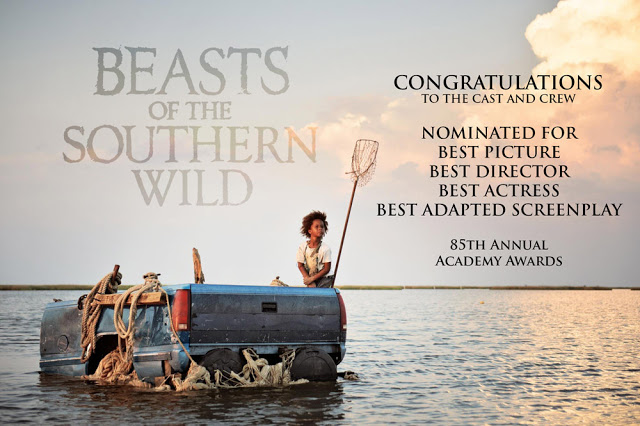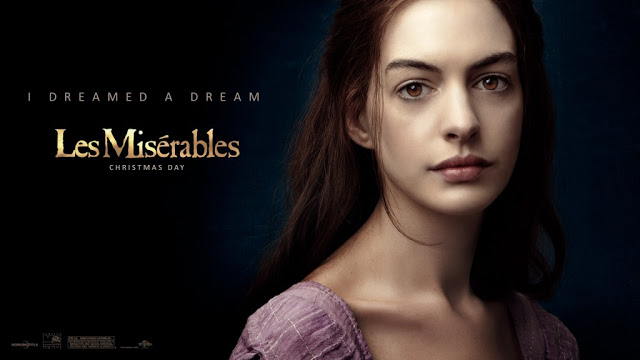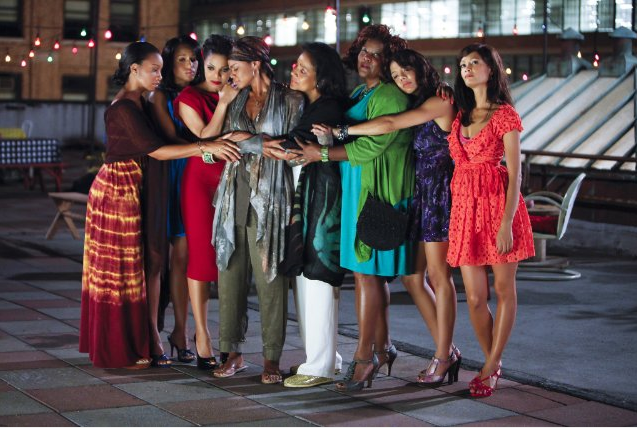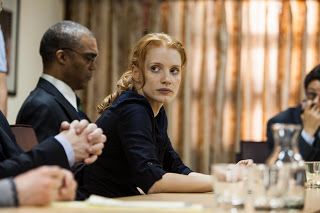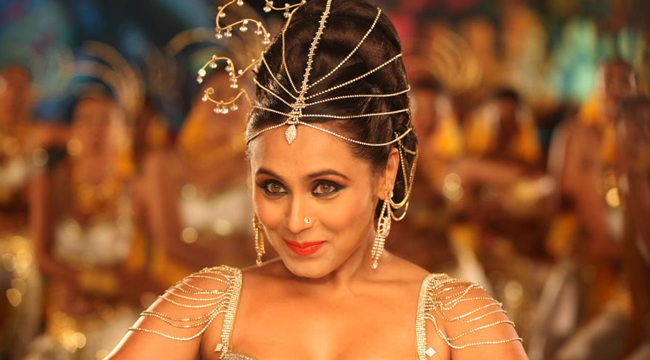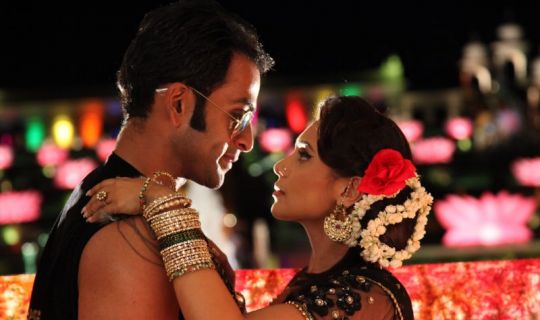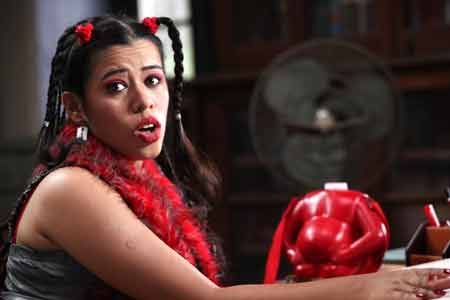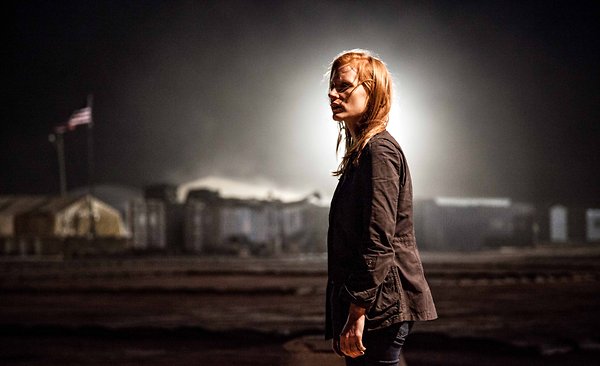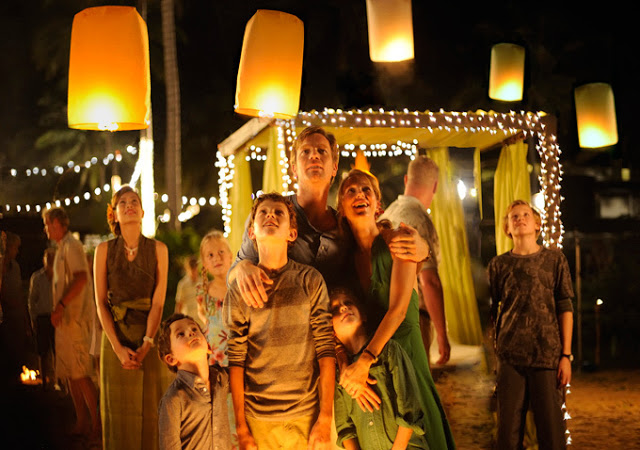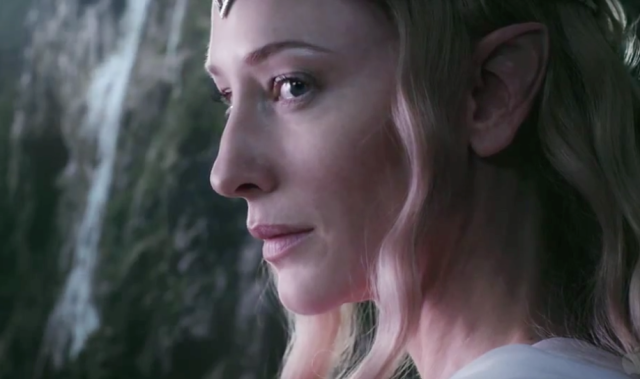 |
| Galadriel (Cate Blanchett) in The Hobbit: An Unexpected Journey |
Tag: 2010s movies
2013 Oscar Week: Heroic Black Love and Male Privilege in ‘Django Unchained’
“… I am not a fan of Tarantino at all. At all. Generally, I find his work contrived, overly self-conscious, and, frankly, boring. Plus, to me he’s like the worst kind of hipster racist, a grown up version of Justin Timberlake desperately trying to affirm his black card at all times, while thoroughly proving himself to be white as hell…”
 |
| Stephen (Samuel L. Jackson) and Broomhilda von Schaft (Kerry Washington) in Django Unchained |
“And if this dynamic is applicable anywhere in American history, it’s on a slave plantation. Frederick Douglass, in his slave narrative, traced his freedom not to the moment when he escaped to the north but the moment in which he first struck an overseer who attempted to whip him. Quentin Tarantino is the only filmmaker who could pack theatres with multiracial audiences eager to see a black hero murder a dizzying array of white slaveholders and overseers. (And, in all fairness, it’s not likely that a black director would’ve gotten a budget to even attempt such a thing.)”
 |
| Django (Jamie Foxx) and Broomhilda von Schaft (Kerry Washington) in Django Unchained |
2013 Oscar Week: Maya from ‘Zero Dark Thirty’ Is an Emotional Character
“You may be wondering why Maya — so stoic and static throughout her years of hunting — breaks down into sobs when the mission is over… All this comes after a decade of ruthless pursuit, in a career to which she has sacrificed her entire life and, for the audience, more than two hours of watching a character display no hint of an emotion other than vengefulness, dedication, patriotism or anger.”
 |
| Jessica Chastain as Maya in Zero Dark Thirty |
2013 Oscar Week: Cosmology, Gender, and Quvenzhané Wallis: ‘Beasts of the Southern Wild’
 |
| Or, to express that in Internet… |
“We made a hero story with a little girl in it, and she is fighting for her family, not her boyfriend. I never saw that growing up, I thought I had to be a little boy to be a hero.” (BlackBook interview)
“I always felt like there wasn’t a blueprint for father daughter relationships — for them or for us. Because what are they supposed to do with us, treat us like boys, or small women, or what? Father daughter relationships are so unique from family to family, and I’d love to watch it explored more onstage.” (Barnes & Noble interview)
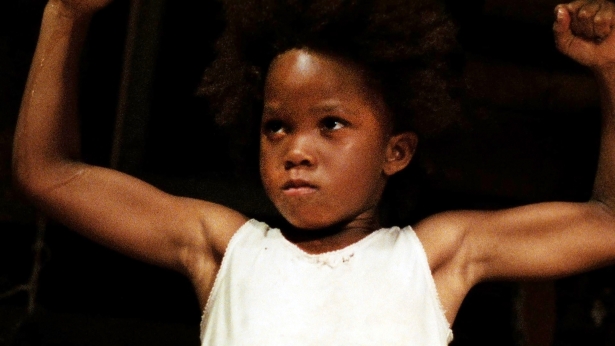 |
| Hushpuppy, being a man. |
“God isn’t this distant thing. God is right here with you all the time. He’s your buddy, and you can talk about everything. And writing this play and working on the film, seeing it, I felt God’s presence. I just had more of a sense of my place in the whole scope of everything.” (Elle interview)
 |
| “I see that I’m a little piece in a big, big universe. And that makes things right.” |
2013 Oscar Week: ‘Les Misérables’: Some Musicals Are More Feminist Than Others
“…the plight of women in his society, especially the grisettes (working class young women) and prostitutes, and how they were helpless against not just men of power, but men in general, and how nice poor girls could so easily be discarded and have [their lives] ruined because of becoming pregnant or rebuffing sexual advances.”
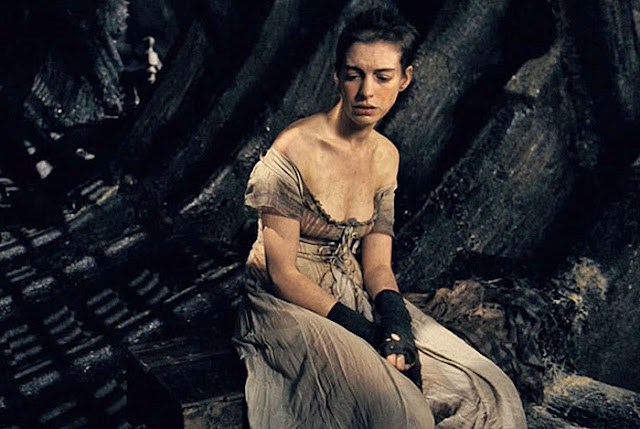 |
| Anne Hathaway as Fantine in Les Miserables |
Lovely ladies
Ready for the call
Standing up or lying down
Or any way at all
Bargain prices up against the wall
Come on, Captain
You can wear your shoes
Don’t it make a change
To have a girl who can’t refuse
Easy money
Lying on a bed
Just as well they never see
The hate that’s in your head
Don’t they know they’re making love
To one already dead!
“What I did was I tried to get inside the reality of her story as it exists in our world. … I read a lot of articles and watched a lot of documentaries and news clips about sexual slavery. And for me, for this particular story, I came to the realization that I had been thinking about Fantine as someone who lived in the past, but she doesn’t. She’s living in New York City right now. She’s probably less than a block away. This injustice exists in our world, and so every day that I was her, I just thought—this isn’t an invention. This isn’t me acting. This is me honoring that this pain lives in this world and I hope that in all our lifetimes — like, today — we see it end.”
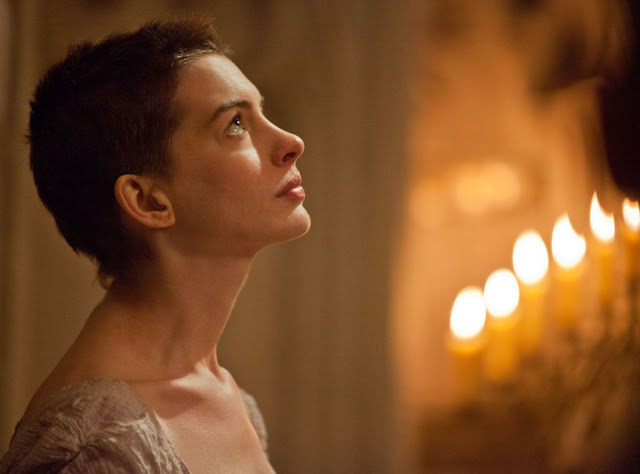 |
| Anne Hathaway as Fantine in Les Miserables |
Regardless of what can be said about Hathaway’s weight loss for the role (critiqued here), her framing of Fantine as a sexual slave, NOT a prostitute, is key, as it refuses to glorify or joke about what is so often swept under the rug regarding sex work: that the majority of women do not “choose” it but are forced into it–a realization emphasized by Hugo but often lost in musical renditions. Hugo writes of Fantine,
“What is the history of Fantine? It is society buying a slave. From whom? From misery. From hunger, from cold, from loneliness, from abandonment, from privation. Melancholy barter. A soul for a bit of bread. Misery makes the offer, society accepts … it is said that slavery has disappeared from the European civilization. This is a mistake. It still exists: but it weighs now only upon woman, and it is called prostitution.”
 |
| Amanda Seyfried as Cosette in Les Miserables |
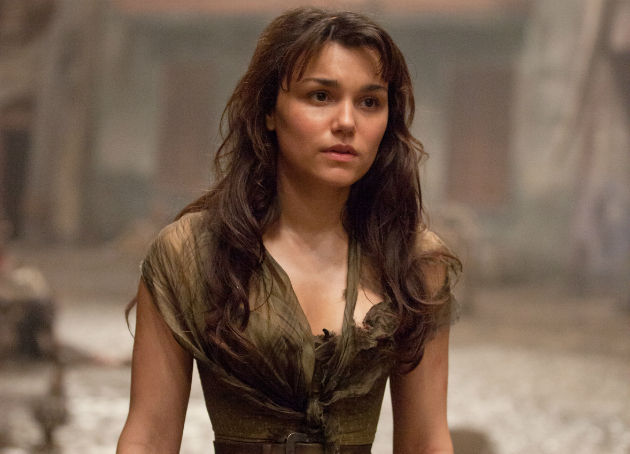 |
| Samanta Barks as Eponine in Les Miserables |
Classic Literature Film Adaptations Week: ‘For Colored Girls’ Reveals Power of Sisterly Solidarity & Women Finding Their Voice
I was excited to see For Colored Girls. A film about 9 women, as a feminist, how could I not be? But I have to admit, I questioned whether or not I should even be writing this review. Writing about a film revolving around African-American women, based on a seminal play on race, and I’m not a woman of color…would it be inappropriate? Would I be breaking some kind of taboo? But then I realized after reading the play and watching the film, while it speaks to women of color and the experiences they endure, it portrays myriad experiences women face.
I don’t want to diminish the unique racial struggles that women of color encounter in this film and in life for that matter. I will never know what it’s like to be followed in a store because of the color of my skin. I will never be told that I should have babies with a white man so my children will have lighter skin and be prettier. But I think this is an important film for women and men to see for the commentary it makes on gender and race and the struggles women of color endure.
For Colored Girls follows 9 African-American women whose lives intersect in a New York City brownstone. A mosaic of stories as their lives weave together. Janet Jackson is an unyielding corporate magazine mogul with intimacy issues; Loretta Devine, a nurse opening a non-profit clinic dating an unreliable boyfriend; Anika Noni Rose, an effervescent and optimistic dance instructor; Kerry Washington, a happily married social worker who can’t have the one thing she so desperately wants; Kimberly Elise, Jackson’s personal assistant and a mother of two living in an abusive relationship; Phylicia Rashad, the all-knowing wise neighbor; Whoopi Goldberg a devoutly religious woman and mother of Thandie Newton, a promiscuous woman with a thirst for life and a painful past, and Tessa Thompson, a teen who aspires to be a dancer. Almost every aspect of a woman’s life is shown: sex, losing virginity, abortion, rape, falling in love, jealousy, domestic violence, murder, sisterhood, motherhood, infidelity, infertility, break-ups and friendship.
 The film For Colored Girls is Tyler Perry’s adaptation of the critically acclaimed Obie award-winning 1974 play and choreopoem For Colored Girls Who Have Considered Suicide When the Rainbow is Enuf written by Ntozake Shange. I had never even heard of the play until a couple of years ago when my co-worker Nai adamantly insisted that I must read it. I was so glad she did as I was blown away by Shange’s brutally honest yet devastatingly beautiful prose. It’s raw and rhythmic, moving with a fierce visceral cadence. In the play, each woman is represented by a color: red, blue, yellow and so on. With striking visuals, the film incorporates this theme by having each of the women who signify wear outfits and garments that symbolize that color. When one of the women is raped, she stops wearing her bright color, donning black clothing instead, as if the trauma had drained her color, her vibrancy. Each woman was so unique: different classes, ages, shades of black (as my co-worker pointed out). It’s rare to find a powerful woman lead a film; it’s almost unheard of for a film to tell nine women’s distinctive tales. The movie and the play both open with these pleading words:
The film For Colored Girls is Tyler Perry’s adaptation of the critically acclaimed Obie award-winning 1974 play and choreopoem For Colored Girls Who Have Considered Suicide When the Rainbow is Enuf written by Ntozake Shange. I had never even heard of the play until a couple of years ago when my co-worker Nai adamantly insisted that I must read it. I was so glad she did as I was blown away by Shange’s brutally honest yet devastatingly beautiful prose. It’s raw and rhythmic, moving with a fierce visceral cadence. In the play, each woman is represented by a color: red, blue, yellow and so on. With striking visuals, the film incorporates this theme by having each of the women who signify wear outfits and garments that symbolize that color. When one of the women is raped, she stops wearing her bright color, donning black clothing instead, as if the trauma had drained her color, her vibrancy. Each woman was so unique: different classes, ages, shades of black (as my co-worker pointed out). It’s rare to find a powerful woman lead a film; it’s almost unheard of for a film to tell nine women’s distinctive tales. The movie and the play both open with these pleading words:“somebody / anybody sing a black girl’s song bring her out to know herself to know you but sing her rhythms carin / struggle / hard times sing her song of life she’s been dead so long closed in silence so long she doesn’t know the sound of her own voice her infinite beauty she’s half-notes scattered without rhythm / no tune sing her sighs sing the song of her possibilities sing a righteous gospel…”
“Being alive and being a woman is all I got, but being colored is a metaphysical dilemma I haven’t conquered yet.”
“…metal horses gnawin my womb / dead mice fall from my mouth…”
“the stranger we always thought it would be, who never showed up, cuz it turns out the nature of rape has changed…”
“I got a real dead loving here for you now, because I don’t know anymore how to avoid my own face wet with my tears! Because I had convinced myself that colored girls have no right to sorrow!”
“somebody almost walked off wid alla my stuff…like a kleptomaniac workin hard & forgettin while stealin this is mine / this ain’t your stuff…did you know somebody almost got away with me / me in a plastic bag under their arm…”
“…I got sorry greeting me at my front door you can keep yours …I’m gonna haveta throw some away I can’t even get to the clothes in my closet for all the sorries… …well I will not call I’m not goin to be nice I will raise my voice & scream & holler… …& I wont be sorry for none of it”
“That might sound unbearable, but done right it’s thrilling — specific in its pain, universal in its reach — and Mr. Perry works very hard and gets it mostly right.”
“[Perry] gathers together some of the greatest African-American actresses in America — actresses who are lucky to get one or two scenes in a film with a predominantly white cast — in leading roles that let them chase dreams, make mistakes, fall in love, have their hearts broken, flirt, seduce, manipulate, preen, pout, rail against injustice, and endure and transcend Old Testament-level suffering. And they reward Perry with performances so heartfelt, and often so accomplished, that they make all of his films worth seeing no matter what you think of him as a director.”
“…I wanted to jump up outta my bones & be done wit myself leave me alone & go on in the wind it waz too much I fell into a numbness till the only tree I cd see took me up in her branches held me in the breeze made me dawn dew that chill at daybreak the sun wrapped me up swingin rose light everywhere the sky laid over me like a million men I waz cold / I was burnin up / a child & endlessly weavin garments for the moon wit my tears I found god in myself & I loved her / I loved her fiercely”
“the best way to reframe perceptions is not through information or knowledge or education…but through the arts, through literature, through film. These are the things that really break down the boundaries and borders between us…”
‘Hansel and Gretel Witch Hunters’ Trailer
The ‘Zero Dark Thirty’ Controversy: What Does Jessica Chastain’s Beauty Have to Do With It?
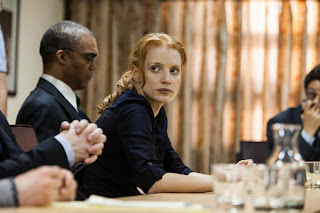 |
| The beautiful Jessica Chastain in Zero Dark Thirty |
This was originally posted at The Funny Feminist.
David Clennon does not want you to vote for Zero Dark Thirty for any single Academy Award.
Who is David Clennon, you might ask? An actor and activist who is a voting member of the Academy of Motion Picture Arts and Sciences. He does not want you – and by “you,” I mean other members of the Academy – to vote for Zero Dark Thirty in the five categories which the film was nominated. He does not want anyone to vote for Zero Dark Thirty in the Best Picture, Actress, Original Screenplay, Film Editing, or Sound Editing categories.
 |
| Kathryn Bigelow? NO MORE OSCARS FOR YOU! |
He does not want anyone to do this because he believes Zero Dark Thirty promotes torture. He also believes that Jessica Chastain should not be rewarded for her performance in the film because actors have moral obligations to choose their projects well. He writes on truth-out.org:
“Everyone who contributes skill and energy to a motion picture – including actors – shares responsibility for the impressions the picture makes and the ideas it expresses. If I had played the role that was offered to me on Fox’s 24 (Season 7), I would have been guilty of promoting torture, and I couldn’t have evaded my own responsibility by blaming the writers and directors. So Jessica Chastain won’t get my vote for Best Actress. With her beauty and her tough-but-vulnerable posturing, she almost succeeds in making extreme brutality look weirdly heroic.”
There are many things about this piece that are reactionary and completely misinterpret the point of Bigelow’s complicated film, and many things about the extreme backlash to Zero Dark Thirty that are ill-considered.
For now, though, I have only one question: what does Jessica Chastain’s beauty have to do with it?
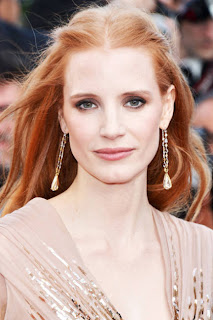 |
| The gorgeous Jessica Chastain |
Clennon mentions Chastain’s beauty later in the piece as well:
“Later, the female interrogator (and Zero’s heroine Maya [Chastain]), supervises the beating and near-drowning (aka waterboarding) of another detainee, Faraj; he gasps for air, gags, shudders and chokes; director Kathryn Bigelow then shows Chastain in a clean, well-lighted restroom, looking pretty, but tired and frustrated; Bigelow does not give us a view of Faraj after his ordeal.”
Again, I ask the question: what does Jessica Chastain’s beauty have to do with it?
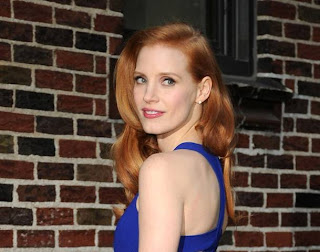 |
| The lovely Jessica Chastain |
It seems strange to me that her looks are mentioned twice in an article that has a count of fewer than 600 words.
Clennon isn’t the only one who uses that adjective in describing Chastain’s character. Marjorie Cohn’s piece at The Huffington Post also calls Maya the “beautiful heroine” – a beautiful heroine who says that she’s “fine” in response to watching a detainee get tortured:
“Torture is also illegal and immoral — important points that are ignored in Zero Dark Thirty. After witnessing the savage beating of a detainee at the beginning of the film, the beautiful heroine ‘Maya’ says ‘I’m fine.’”
Once more, with feeling: what does Jessica Chastain’s beauty have to do with it?
 |
| Did we mention she’s a hottie? |
I don’t think Jessica Chastain’s physical attractiveness is remotely relevant to the film’s stance on torture, but apparently, these writers do. They link her beauty with her supposed heroism. Clenon does this most blatantly by stating that Chastain’s beauty, combined with her tough-yet-vulnerable personality, almost makes torture seem heroic.
It seems to me that these writers, Clenon particular, has swallowed the Beauty Equals Goodness trope hook, line, and sinker. At the very least, they’ve been conditioned to believe that “beautiful woman = heroic woman” in a Hollywood movie, that Chastain’s beauty is the director’s way of telling the audience that we’re supposed to see her as the moral center of the film.
This is a sign, to me, that much of the criticism surrounding Zero Dark Thirty has roots in a very latent, subtle form of sexism. Jessica Chastain is a beautiful woman, and therefore her character must be the moral center of the film, a spokesperson for both the film’s message and the director’s beliefs. Beautiful women only exist in mainstream film to be rescued, to be prizes for the male characters, or to be the film’s moral center. Maya does not need to be rescued and is no prize for a male lead (because there isn’t one), so therefore she’s the moral center, and omg this movie supports torture!
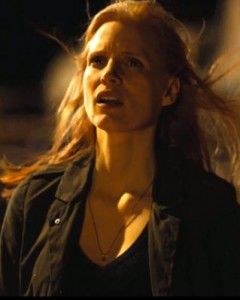 |
| Girl purdy, ergo she must be stating the film’s message |
Am I reaching with this theory? Perhaps. But I can’t help notice that, even though Clenon cautions the Academy to avoid awarding any Oscars to Zero Dark Thirty, Chastain and Bigelow are the only two people he mentions by name. He never once mentions the name of Mark Boal, the screenwriter who penned those torture scenes he found so offensive and morally wrong. He never says “the screenwriter,” period. All of the attention is on either Chastain or Bigelow, not writer.
He mentions that when he was choosing parts, it would have been unfair of him as an actor to put all the blame on the director and writers for their material. Yet in his article on Zero Dark Thirty, he does put some blame on the director – yet not the writer.
 |
| Screenwriter Mark Boal. Attractiveness level irrelevant. |
It doesn’t take a genius to play “one of these things is not like the other” with Jessica Chastain, Kathryn Bigelow, and Mark Boal. Anyone with a background of watching Sesame Street can guess why Boal’s name was left out of this plea to other members of the Academy, why the screenwriter let completely off of the hook.
Bigelow, on the other hand, is apparently no better than Leni Riefenstahl.
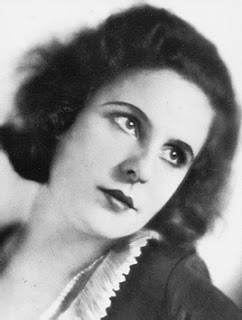 |
| Pictured: Leni Riefenstahl. Not Kathryn Bigelow. |
Bigelow, like Chastain, is also an attractive woman. So attractive that prominent writers (or writers who were once prominent ages ago) believe that she only receives acclaim because of her physical beauty.
It appears that when women step out of their designated roles to be moral centers of a story, they are no better than Nazi propagandists.
When beauty fails to equal goodness, Beauty is Bad.
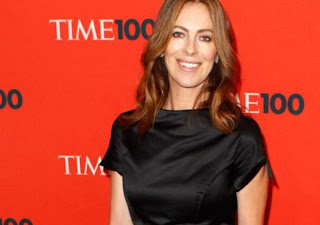 |
| The face of evil, apparently |
Interestingly enough, Jason Clarke, the actor who plays the torturer CIA agent Dan in Zero Dark Thirty, is a handsome man. I never assumed that I was meant to find his actions morally correct, or view him as a moral authority, because he was handsome.
I also never assumed that I was meant to find his actions morally correct, or view him as a moral authority, because he was a man.
It’s a shame that Bigelow didn’t cast an ugly woman or a man in the lead role of Maya. Then the audience would have known right away that the protagonist was not necessarily meant to be a hero, and this confusion over the film’s stance on torture would never have occurred.
 |
||
| Actor Jason Clarke. Attractiveness level also irrelevant. |
The ‘Zero Dark Thirty’ Controversy: What Does Jessica Chastain’s Beauty Have to Do With It?
 |
| The beautiful Jessica Chastain in Zero Dark Thirty |
This was originally posted at The Funny Feminist.
David Clennon does not want you to vote for Zero Dark Thirty for any single Academy Award.
Who is David Clennon, you might ask? An actor and activist who is a voting member of the Academy of Motion Picture Arts and Sciences. He does not want you – and by “you,” I mean other members of the Academy – to vote for Zero Dark Thirty in the five categories which the film was nominated. He does not want anyone to vote for Zero Dark Thirty in the Best Picture, Actress, Original Screenplay, Film Editing, or Sound Editing categories.
 |
| Kathryn Bigelow? NO MORE OSCARS FOR YOU! |
He does not want anyone to do this because he believes Zero Dark Thirty promotes torture. He also believes that Jessica Chastain should not be rewarded for her performance in the film because actors have moral obligations to choose their projects well. He writes on truth-out.org:
“Everyone who contributes skill and energy to a motion picture – including actors – shares responsibility for the impressions the picture makes and the ideas it expresses. If I had played the role that was offered to me on Fox’s 24 (Season 7), I would have been guilty of promoting torture, and I couldn’t have evaded my own responsibility by blaming the writers and directors. So Jessica Chastain won’t get my vote for Best Actress. With her beauty and her tough-but-vulnerable posturing, she almost succeeds in making extreme brutality look weirdly heroic.”
There are many things about this piece that are reactionary and completely misinterpret the point of Bigelow’s complicated film, and many things about the extreme backlash to Zero Dark Thirty that are ill-considered.
For now, though, I have only one question: what does Jessica Chastain’s beauty have to do with it?
 |
| The gorgeous Jessica Chastain |
Clennon mentions Chastain’s beauty later in the piece as well:
“Later, the female interrogator (and Zero’s heroine Maya [Chastain]), supervises the beating and near-drowning (aka waterboarding) of another detainee, Faraj; he gasps for air, gags, shudders and chokes; director Kathryn Bigelow then shows Chastain in a clean, well-lighted restroom, looking pretty, but tired and frustrated; Bigelow does not give us a view of Faraj after his ordeal.”
Again, I ask the question: what does Jessica Chastain’s beauty have to do with it?
 |
| The lovely Jessica Chastain |
It seems strange to me that her looks are mentioned twice in an article that has a count of fewer than 600 words.
Clennon isn’t the only one who uses that adjective in describing Chastain’s character. Marjorie Cohn’s piece at The Huffington Post also calls Maya the “beautiful heroine” – a beautiful heroine who says that she’s “fine” in response to watching a detainee get tortured:
“Torture is also illegal and immoral — important points that are ignored in Zero Dark Thirty. After witnessing the savage beating of a detainee at the beginning of the film, the beautiful heroine ‘Maya’ says ‘I’m fine.’”
Once more, with feeling: what does Jessica Chastain’s beauty have to do with it?
 |
| Did we mention she’s a hottie? |
I don’t think Jessica Chastain’s physical attractiveness is remotely relevant to the film’s stance on torture, but apparently, these writers do. They link her beauty with her supposed heroism. Clenon does this most blatantly by stating that Chastain’s beauty, combined with her tough-yet-vulnerable personality, almost makes torture seem heroic.
It seems to me that these writers, Clenon particular, has swallowed the Beauty Equals Goodness trope hook, line, and sinker. At the very least, they’ve been conditioned to believe that “beautiful woman = heroic woman” in a Hollywood movie, that Chastain’s beauty is the director’s way of telling the audience that we’re supposed to see her as the moral center of the film.
This is a sign, to me, that much of the criticism surrounding Zero Dark Thirty has roots in a very latent, subtle form of sexism. Jessica Chastain is a beautiful woman, and therefore her character must be the moral center of the film, a spokesperson for both the film’s message and the director’s beliefs. Beautiful women only exist in mainstream film to be rescued, to be prizes for the male characters, or to be the film’s moral center. Maya does not need to be rescued and is no prize for a male lead (because there isn’t one), so therefore she’s the moral center, and omg this movie supports torture!
 |
| Girl purdy, ergo she must be stating the film’s message |
Am I reaching with this theory? Perhaps. But I can’t help notice that, even though Clenon cautions the Academy to avoid awarding any Oscars to Zero Dark Thirty, Chastain and Bigelow are the only two people he mentions by name. He never once mentions the name of Mark Boal, the screenwriter who penned those torture scenes he found so offensive and morally wrong. He never says “the screenwriter,” period. All of the attention is on either Chastain or Bigelow, not writer.
He mentions that when he was choosing parts, it would have been unfair of him as an actor to put all the blame on the director and writers for their material. Yet in his article on Zero Dark Thirty, he does put some blame on the director – yet not the writer.
 |
| Screenwriter Mark Boal. Attractiveness level irrelevant. |
It doesn’t take a genius to play “one of these things is not like the other” with Jessica Chastain, Kathryn Bigelow, and Mark Boal. Anyone with a background of watching Sesame Street can guess why Boal’s name was left out of this plea to other members of the Academy, why the screenwriter let completely off of the hook.
Bigelow, on the other hand, is apparently no better than Leni Riefenstahl.
 |
| Pictured: Leni Riefenstahl. Not Kathryn Bigelow. |
Bigelow, like Chastain, is also an attractive woman. So attractive that prominent writers (or writers who were once prominent ages ago) believe that she only receives acclaim because of her physical beauty.
It appears that when women step out of their designated roles to be moral centers of a story, they are no better than Nazi propagandists.
When beauty fails to equal goodness, Beauty is Bad.
 |
| The face of evil, apparently |
Interestingly enough, Jason Clarke, the actor who plays the torturer CIA agent Dan in Zero Dark Thirty, is a handsome man. I never assumed that I was meant to find his actions morally correct, or view him as a moral authority, because he was handsome.
I also never assumed that I was meant to find his actions morally correct, or view him as a moral authority, because he was a man.
It’s a shame that Bigelow didn’t cast an ugly woman or a man in the lead role of Maya. Then the audience would have known right away that the protagonist was not necessarily meant to be a hero, and this confusion over the film’s stance on torture would never have occurred.
 |
||
| Actor Jason Clarke. Attractiveness level also irrelevant. |
Guest Post: Feminism in ‘Aiyyaa,’ and Why It Ain’t Such A Bad Movie
 |
| Aiyyaa |
Guest post written by Rhea Daniel.
Aiyyaa shows how a perfectly loving Indian family, specifically a Marathi family (but this sort of traditionalism runs right across this arranged-marriage loving country so an Indian woman can relate) can make their female offspring miserable over the subject of her single-hood up to to the point where she’ll resort to taking any low-paying job as an excuse to stay out of home as long as she can. But leave home on her own terms she won’t, she needs a man first. She keeps fantasizing about packing up in the middle of the night, grabbing her mum’s gold jewellery and running away with her dream-man. Yes, she’s a romantic, a Bollywood fan and her ambitions extend thus far to falling in love and living HEA.
Understanding the Arranged Marriage:
Also, get ready to take on the roles Meenakshi’s already faking, you have very few moments to be yourself. Meenakshi dresses up seemingly voluntarily for the sit-downs, seems to be making an effort, but the audience knows that it’s an act. So why can’t she just say no, right? To understand why being in such a situation is like being stuck between a rock and a hard place take a look first at this fascinating TED talk by Sheena Iyengar on how Asians view choice:
She falls for Surya, a Tamilian artist who visits the library she works in. She does her own version of the arranged-marriage research, asking people he’s acquainted with all sorts of questions about his personality etc. Her colleague informs that he is rumoured to drink and do drugs, that’s why his eyes are so red, but it doesn’t faze her. She tries to find out more about his culture. She’s advised to watch Tamil movies. She learns the language, beginning with sexually suggestive compliments, learning how to say “please leave your shirt button open” in Tamil. She goes dreamy-eyed every time he passes and swoony over his after-shave (or body-odour, whatever it is). It might help to know that the entire movie is the based on one of stories from the Marathi movie Gandha (2009) (translated to ‘smell’ or ‘fragrance’) by the same director. Meenakshi seems sensitive to any noxious type smells. Her olfactory sense seems to be her love-guide. She hates the smell of the college toilets, but there’s a scene where she trance-walks into the men’s loo because she can smell Surya in there. Lucky for Surya he was just washing his face. Imagine someone standing outside your toilet cubicle smelling your farts.
Despite this movie’s sprinkling of annoying Bollywood fantasy numbers (which I skipped) and occasional mind-numbingly loopy, loud scenes, most of it was gratifyingly funny. In Meenakshi’s declaration of love for dark people (technically what she says translates to “I don’t like light-skinned people, I like black people”) she’s referring to her love for South-Indian Surya, but it comes across as a taunt to the Indian majority that views ‘fairness’ as as a prerequisite for attractiveness. The only incongruity of this statement is that Malayali actor Prithviraj doesn’t qualify as ‘dark’ by any Indian standard, so it makes her declaration specific to his race (South-Indians are stereotyped as dark-skinned) and her willingness to integrate with them. Dreamum-wakuppam, a parodied version of South-Indian dance numbers (not to mention the language) can seem insulting at first***, but by the end of the movie she’s transformed into a traditional Tamil bride, and speaks Tamil like she can’t help it. Her exclamations of ‘aiyyaa!’ change into the South-Indian ‘aiyyoo!’ Having visited a traditional Marwari household in Pondicherry and Gujarati household in Chennai who regularly feast on idli–dosa made by their super-traditional sari-clad wives, I’d believe the integration is not just for survival, it’s embraced.
I know that wives have cheated on their husbands in Bollywood before, I know they’ve also shown cheating husbands the door, but these stories have remained distant scandals before. Caught between one’s desire for freedom and one’s cultural call of doody ie., to marry and reproduce, is a common cross to bear in this country, and I’ve never come across a Bollywood movie that didn’t conveniently villainize the parents/society in order to dramatize the girl or boy’s situation. So despite all the mayhem Ayyiaa manages to make itself a predominantly feminist film, and had some subtle observations to make that shone like little jewels through the script.
*Preferring to remain single is an alien concept, let’s not even go there.
**Didn’t really like the way that was advertized, man-hunting seems to refer to a search ranging across several men, when she quite obviously interested only in The One.
2013 Golden Globes Week: ‘Zero Dark Thirty’ Raises Questions On Gender and Torture, Gives No Easy Answers
 |
| Jessica Chastain as Maya in Zero Dark Thirty |
Written by Megan Kearns. | Warning: Spoilers ahead!!
Driven, relentless, bad-ass women in film always hold a special place in my heart. Ripley from Alien and Aliens, Patty Hewes from Damages, Carrie Mathison from Homeland. Maya, the female protagonist of Zero Dark Thirty, is no exception. But can a film be feminist if it depicts horrific violations of human rights?
As Candice Frederick asserts, Maya anchors and propels the film. With a woman at the center of this story, it’s hard not to question gender. Zero Dark Thirty doesn’t overtly discuss gender politics, as Bigelow points out. Yet it reveals gender dynamics in subtle and important ways.
 |
| Maya (Jessica Chastain) in Zero Dark Thirty |
One of the best things about having a female director? Not only do we see an intelligent and complex female protagonist. We also see female friendship. Passing the Bechdel Test, we see Maya and her colleague and friend Jessica (Jennifer Ehle) debate, strategize, unwind and challenge each other. Reinforcing their friendship with a visual cue, Maya’s screensaver on her computer is a picture of her and Jessica.
 |
| Jennifer Ehle as Jessica in Zero Dark Thirty |
 |
| Maya (Jessica Chastain) in Zero Dark Thirty |
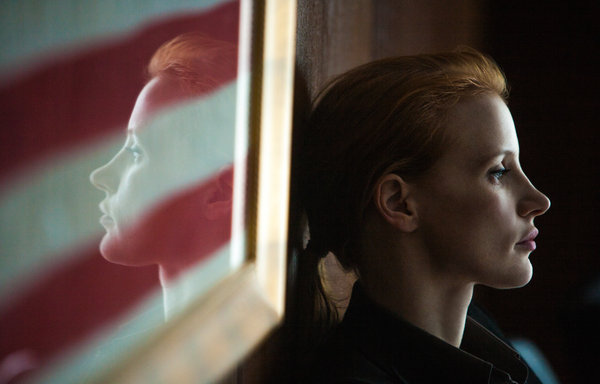 |
| Maya (Jessica Chastain) in Zero Dark Thirty |
Torture does not yield accurate information. Yet Dan repeatedly says to Ammar, “You lie, I hurt you.” When Ammar begs Maya for help, she tells him, “You can help yourself by telling the truth.” Not only does it subvert our gendered assumptions that she would be sympathetic to him. It puts the onus on the tortured detainees, not on the racist atrocities committed by government officials.
 |
| Admiral Bill McCraven (Christopher Stanley) and Maya (Jessica Chastain) in Zero Dark Thirty |
 |
| Maya (Jessica Chastain) in Zero Dark Thirty |
2013 Golden Globes Week: It’s “Impossible” Not to See the White-Centric Point of View
Written by Lady T, originally published at The Funny Feminist.
So this is a trailer for the upcoming film, The Impossible, telling the story about the 2004 tsunami:
There are a few title cards in the trailer that provide the necessary background for the story. The trailer helpfully tells you, “In 2004, tragedy struck southeast Asia.”
However, I don’t think those title cards are specific enough. I’d like to revise those title cards so they read, “In 2004, tragedy devastated entire nations, but we’re going to focus on one white family that was on vacation there.”
The Impossible is based on a true story of a real family that was separated during the tsunami and eventually reunited, each family member miraculously surviving. I can easily see why this story would appeal so much to filmmakers. “Family separated, in peril, in a devastated nation that is completely foreign to them” is such a great hook that it’s practically Captain Hook. Who wouldn’t be interested in the story of a family who have to survive in a country that isn’t their own?
On the other hand, this is a real-life tsunami that affected entire nations, that devastated the lives of the citizens who lived there, and the first prominent film about the tragedy is about white people who were staying at a hotel?
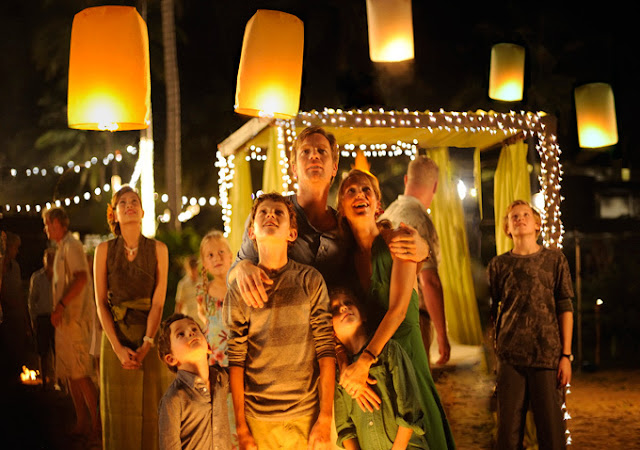 |
| The family in The Impossible |
Landon Palmer at the Culture Warrior has more to say on this:
“There is no reason to say that this experience wasn’t any less traumatic and devastating for those visiting (regardless of their particular race) than the inhabitants (once again, regardless of their particular race) of any of the affected nations. The problem with The Impossible trailer isn’t the depiction family’s experience of the tragedy itself, but its implications about what happens when, say, the film ends. While watching the trailer for the first time, an image kept appearing in my head of an exhausted, scratched-up family sleeping comfortably on a plane returning them safely to their home of origin. Being able to survive and then leave a tragedy is altogether different than having everything that is familiar, including one’s home, fall apart before your eyes. However, years of uncertain reconstruction and rehabilitation doesn’t fit the formula of a Hollywood ending quite like a welcome return to a home far, far away from moving tectonic plates.”
Or, you can read a briefer, much more blunt article at 8Asians here, titled “The Impossible Trailer Features Pretty White People Surviving Indonesian Tsunami.”
There are some who might say that one can’t judge a film before seeing it, but to quote our illustrious vice-president, that’s a bunch of malarkey. The purpose of trailers is to market the film and let viewers decide whether or not they want to see it. If a person does not want to see The Impossible because they don’t want to see, as my friend put it, “the tsunami from the perspective of the 1%,” that is a legitimate reason to not see the film.
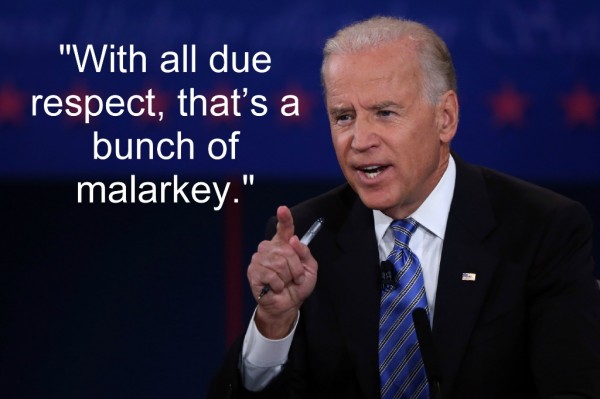 |
| You tell ’em, Joe. |
As for me, I will probably see The Impossible. Naomi Watts scored a Best Actress nomination for the part , and I’m a huge Oscar fan who likes to see as many nominated films as possible from the Picture, Director, Acting, and Screenplay categories. The film also looks beautifully shot. Who knows? The Impossible could be a legitimately good movie.
Still, I can’t help but feel that the real impossible task is making a movie about tragedies that affect non-white people and expecting the film to get the same attention as one that stars Naomi Watts and Ewan McGregor.
———-
Lady T is a writer with two novels, a play, and a collection of comedy sketches in progress. She hopes to one day be published and finish one of her projects (not in that order). You can find more of her writing at www.theresabasile.com, where she picks apart entertainment and reviews movies she hasn’t seen.
